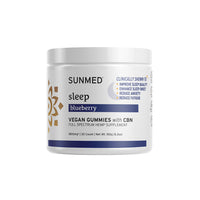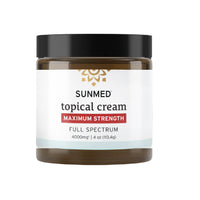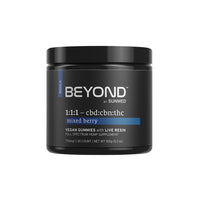CBD for Shingles: Can It Help?
Find out if CBD can help ease discomfort related to shingles and how to incorporate it into your wellness routine with Sunmed.

Shingles is a viral condition that can cause significant discomfort, often appearing as a painful rash that follows nerve pathways.
It’s caused by the varicella-zoster virus — the same virus responsible for chickenpox — which can reactivate later in life. While antiviral medications are the primary approach for managing shingles, many people seek additional ways to support their well-being.
CBD has gained attention for its potential neuroprotective and soothing properties, leading some to wonder: can CBD help with shingles-related discomfort, too? While CBD is not a treatment for shingles, research suggests that it may play a role in promoting relaxation, easing feelings of tension, and supporting skin health.*
What is shingles?
Shingles develops when the varicella-zoster virus, which remains dormant in the body after a chickenpox infection, reactivates. This often happens due to aging, stress, or a weakened immune system. The condition primarily affects the nerves and skin, leading to a rash that can cause burning, itching, or sensitivity.
One of the most challenging aspects of shingles is the nerve-related discomfort that can persist even after the rash disappears. This is known as postherpetic neuralgia (PHN), a condition where nerve endings continue to send signals of discomfort even though the skin has healed.
Traditional approaches to managing shingles and PHN include antiviral medications, which help manage the viral outbreak, and topical creams that provide temporary relief. However, some individuals explore additional ways to support their well-being, which is where CBD comes into the conversation.
How does CBD interact with the body?
CBD, or cannabidiol, is a compound derived from the hemp and cannabis plant that interacts with the body's endocannabinoid system (ECS) — a complex network that helps regulate various functions, including nerve signaling, skin health, and overall balance.*
The ECS consists of cannabinoid receptors (CB1 and CB2) that influence different areas of the body. CB1 receptors are found primarily in the brain and nervous system, while CB2 receptors are associated with immune function and skin health.* CBD doesn’t bind directly to these receptors but instead encourages the body to use its natural cannabinoids more efficiently.
The nervous system plays a central role in how shingles develops, making the role of cannabinoid receptors particularly fascinating.
CBD and discomfort management: What does the science say?
CBD has been studied for its potential to support relaxation, ease feelings of tension, and promote general comfort.* While no current research directly links CBD to shingles relief, studies suggest that it may have properties that support individuals navigating discomfort.*
Neuroprotective potential
Research indicates that CBD may play a role in supporting nervous system health by interacting with ECS receptors that influence nerve signaling.* Studies examining CBD’s potential in helping manage nerve-related discomfort can be of particular interest, as shingles impacts nerve pathways.*
Relaxation and mood support
Emotional wellness is an important factor when dealing with discomfort. Studies suggest that CBD can work with CB receptors and endocannabinoids in the brain to help promote a sense of calm and support full-body relaxation, which may be helpful for those experiencing nerve-related tension.*
Soothing effects for skin
CBD-infused topicals are commonly used to help nourish and balance the skin.* Since shingles often causes irritation and sensitivity, some individuals apply CBD creams or balms to promote a soothing effect.*
While CBD may help ease discomfort and promote relaxation, it’s important to remember that CBD is not a treatment for shingles, and research is still evolving. However, its potential wellness benefits make it an option worth considering for those looking to support their overall comfort.
How to use CBD for general wellness support
For those considering CBD as part of their wellness routine, there are several ways to incorporate it. The right option depends on personal preferences and wellness goals.
CBD topicals
Creams, balms, and lotions infused with CBD can be applied directly to the skin, offering targeted support. Many of these products also contain botanicals and hydrating ingredients, which may help soothe skin irritation.*
CBD oil and tinctures
Taken sublingually, CBD oil tinctures are absorbed through the mucous membranes under the tongue, allowing for faster absorption. Some individuals use tinctures to help promote relaxation and ease feelings of tension, which can be helpful when navigating nerve-related discomfort.*
CBD edibles and capsules
Gummies and capsules offer a convenient way to incorporate CBD into a routine. These products take longer to absorb but provide a measured serving size that makes consistency easy.
Water-soluble CBD
Water-soluble CBD formulas are designed for fast absorption and can be mixed into beverages. This option is ideal for those who prefer not to take CBD oil directly.
Regardless of the method, consistency is key. Since CBD interacts with the body’s endocannabinoid system, regular use may provide the best results over time.*
Are there any risks to using CBD?
While CBD is widely used and extremely safe for most people, it’s important to consider a few factors before incorporating it into a routine.
Some users may experience minor and temporary side effects when using CBD, such as nausea or lethargy. Starting with a low serving size and gradually adjusting based on individual needs can help limit the risk of unwanted effects.
CBD may also interact with certain medications or supplements, such as blood thinners. Those taking medications or managing health conditions should consult a healthcare professional before using CBD.
Not all CBD products are created equal. Look for options that provide third-party lab testing to ensure purity and potency. Quality and transparency matter when choosing CBD. Products should be sourced from high-quality hemp and tested for contaminants to ensure safety.
The bottom line
Staying informed on the latest research is one of the best ways to be an educated consumer.
CBD is not a treatment for shingles, but its potential neuroprotective and soothing properties make it an option worth exploring for those seeking additional wellness support.* Whether you’re looking for relaxation, comfort, or a way to nourish your skin, we’re here to help you find a product that fits your needs.
*This statement has not been evaluated by the Food & Drug Administration. This product is not intended to diagnose, treat, cure, or prevent any disease.
Sources:
Shingles symptoms and causes | Mayo Clinic
Cannabinoid Receptors in the Central Nervous System: Their Signaling and Roles in Disease | PMC
Emerging Role of the CB2 Cannabinoid Receptor in Immune Regulation and Therapeutic Prospects | PMC
Therapeutic Potential of Cannabidiol (CBD) for Skin Health and Disorders | PMC











